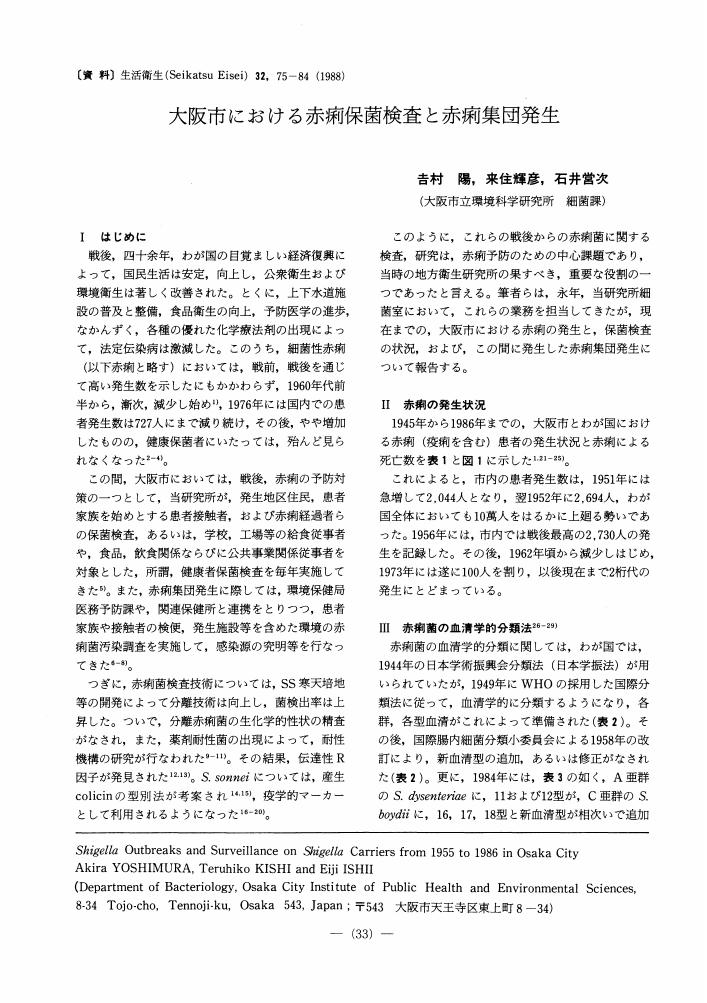8 0 0 0 OA 家庭の台所用スポンジタワシの細菌汚染とその殺菌方法
- 著者
- 石井 営次 乾 美智子 高橋 美帆 塚本 晶子 林 茂美 三浦 和美
- 出版者
- (社)大阪生活衛生協会
- 雑誌
- 生活衛生 (ISSN:05824176)
- 巻号頁・発行日
- vol.35, no.5, pp.228-232, 1991-09-10 (Released:2010-03-11)
- 参考文献数
- 3
- 被引用文献数
- 1
Bacterial contamination in tableware sponge polishers for kitchen use was examined and means for sterilization were sought. Among 36 polishers including 4 for use at places of business, a colony forming unit for each polisher measured by standard plate count, exceeded 109 in 21 polishers, and 108 in 32 polishers, of which a number of coliforms in MPN was more than 106 in each polisher. Although no Salmonella could be detected, Staphylococcus aureus and Bacillus cereus were found in 9 and 15 polishers, respectively. Polishers treated with boiling water every day and which dried easily showed a low number of bacterium, from 102 to 103. Bacterial contaminated polishers were sterilized by boiling water for more than 30 seconds every day, but not by chemicals or disinfectant. Salmonella, S. aureus, and Escherichia coli were found capable of growing in polishers at 25°C.
3 0 0 0 OA カット野菜の細菌汚染と野菜ジュース中での食中毒菌の消長
- 著者
- 石井 営次 瀬下 眞美 三戸 呂隆子 木下 京美
- 出版者
- (社)大阪生活衛生協会
- 雑誌
- 生活衛生 (ISSN:05824176)
- 巻号頁・発行日
- vol.37, no.2, pp.61-66, 1993-03-10 (Released:2010-03-11)
- 参考文献数
- 3
Bacterial contamination was examined in sliced vegetables as one of the types of food, which was prepared from cabbage, lettuce, carrots, onions, cucumbers, tomatos, and/or others. The main component in the sliced vegetables was cabbage. Among 42 samples of the sliced vegetables purchased at retail stores, standerd plate counts (SPCs) of 32 samples were more than 106cfu/g, and coliform group numbers of 38 samples using the most probable number (MPN) were more than 103/g. Escherichia coli and Staphylococcus aureus were isolated from two and one samples, respectively, but other food poisoning bacteria were not. Vegetable juice was prepared from some vegetables purchased at vegetable shops, and SPC and coliform group number were examined. In the juice of cabbage, lettuce, carrots, onions, celery, green peppers, cucumbers, or tomatos, SPCs were 102 to 106cfu/ml and coliform group numbers in MPN did not exceed 103/ml except for carrots (1.1×105). When food poisoning bacteria, isolated in Osaka, were inoculated in each vegetable juice, and survival or growth of the bacteria was examined. Salmonella sp., S. aureus, Yersinia enterocolitica, B. cereus, and E. coli survive in each juice made from cabbage, lettuce, carrots, or onions. S. aureus and E. coli could not grow in onion juice, and Salmonella sp. could not in lettuce and celery juices. Lemon juice used for addition on sliced vegetables was useful for decreasing the bacterial number in sliced vegetables.
2 0 0 0 OA 食中毒菌に対する香辛料の抗菌活性とその利用法の検討
- 著者
- 尾立 純子 石井 営次 山田 浩一
- 出版者
- 一般社団法人 日本調理科学会
- 雑誌
- 日本調理科学会誌 (ISSN:13411535)
- 巻号頁・発行日
- vol.33, no.3, pp.358-364, 2000-08-20 (Released:2013-04-26)
- 参考文献数
- 26
This study was carried out to clarify the antibacterial effects of spices and their ethanol extracts(1g/10m/).Salmonella enteritidis and Escherichia coli strains did not grow after exposure for 120 seconds in water containing the ethanol of clove at more than 8%, and S. entertidis and methicilin-resistant Staphylococcus aureus (MRSA) strains did not grow under the same conditions in water containing the extract of oregano. On the other hand, the aqueous solution containing the 8% extract of rosemary inactivated MRSA with 10 seconds of exposure. The ethanol extract of rosemary among the eight spices tested in this study showed the strongest antibacterial activity against the food-poisoning bacteria.Bacillus cereus did not grow when exposed for 120 seconds in water containing the extract of rosemary at more than 80%.The sensory evaluation by young women panelists showed a preference for chicken seasoned with allspice to over all the other tested powdered spices, this being followed by nutmeg and marjoram preference. Chicken seasoned with ethanol extracts of oregano and sage were preferred over the other extracts. These results were statistically analyzed by the Spearman or Kendall method.
2 0 0 0 OA アメーバの生息環境とレジオネラ感染症
- 著者
- 石井 営次
- 出版者
- Osaka Urban Living and Health Association
- 雑誌
- 生活衛生 (ISSN:05824176)
- 巻号頁・発行日
- vol.47, no.6, pp.320-327, 2003-11-30 (Released:2010-03-11)
- 参考文献数
- 41
1 0 0 0 OA 大阪市における赤痢保菌検査と赤痢集団発生
- 著者
- 吉村 陽 来住 輝彦 石井 営次
- 出版者
- Osaka Urban Living and Health Association
- 雑誌
- 生活衛生 (ISSN:05824176)
- 巻号頁・発行日
- vol.32, no.2, pp.75-84, 1988-03-10 (Released:2010-03-11)
- 参考文献数
- 33

